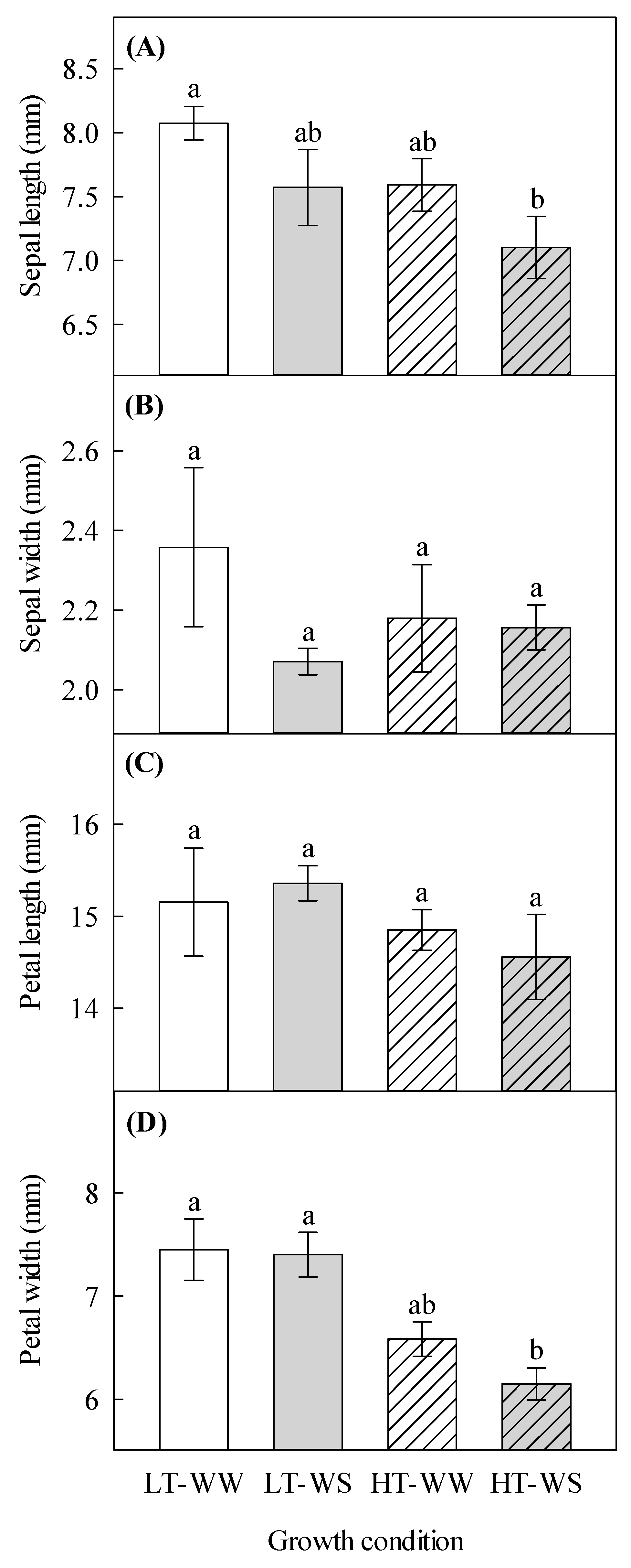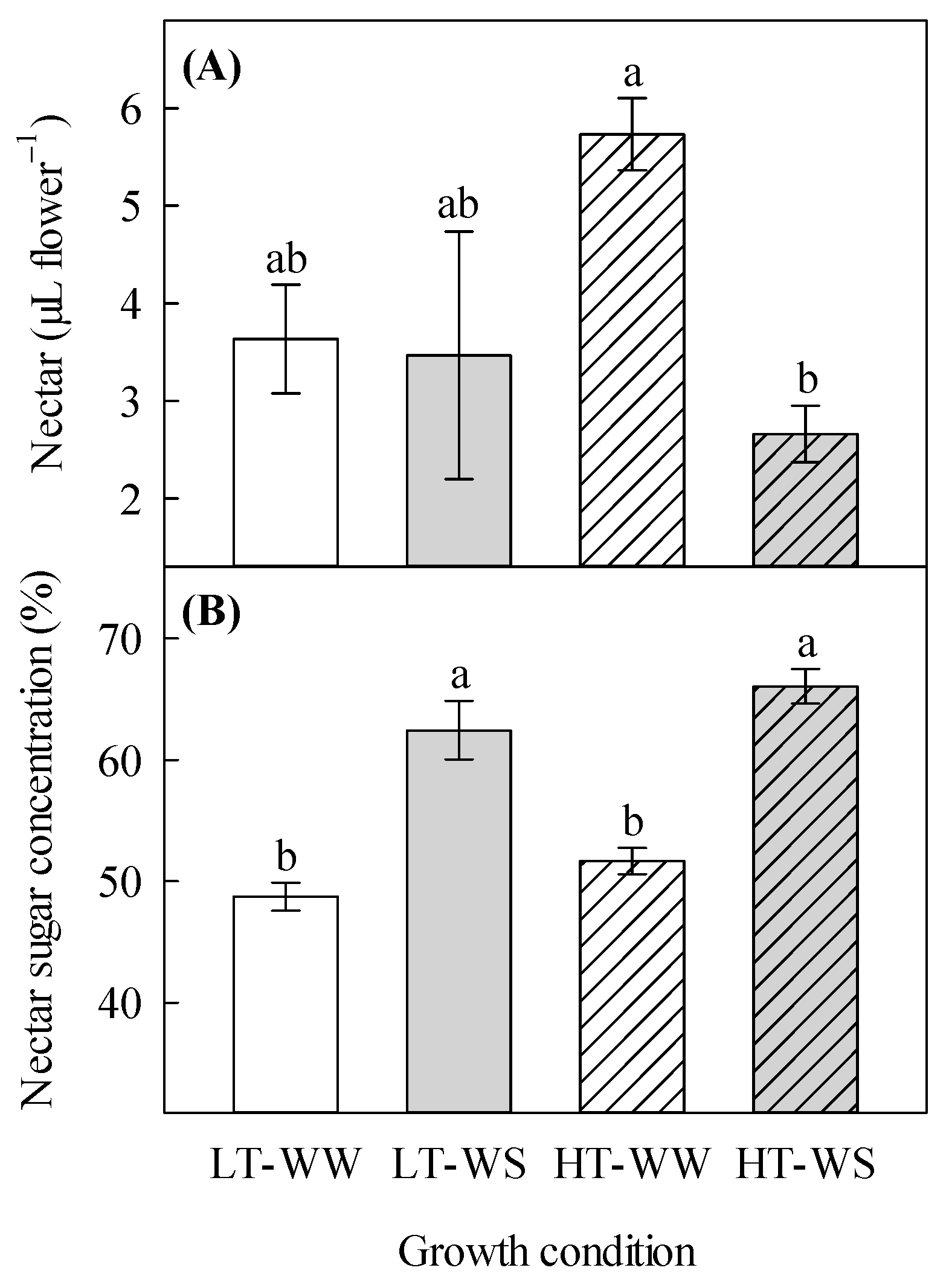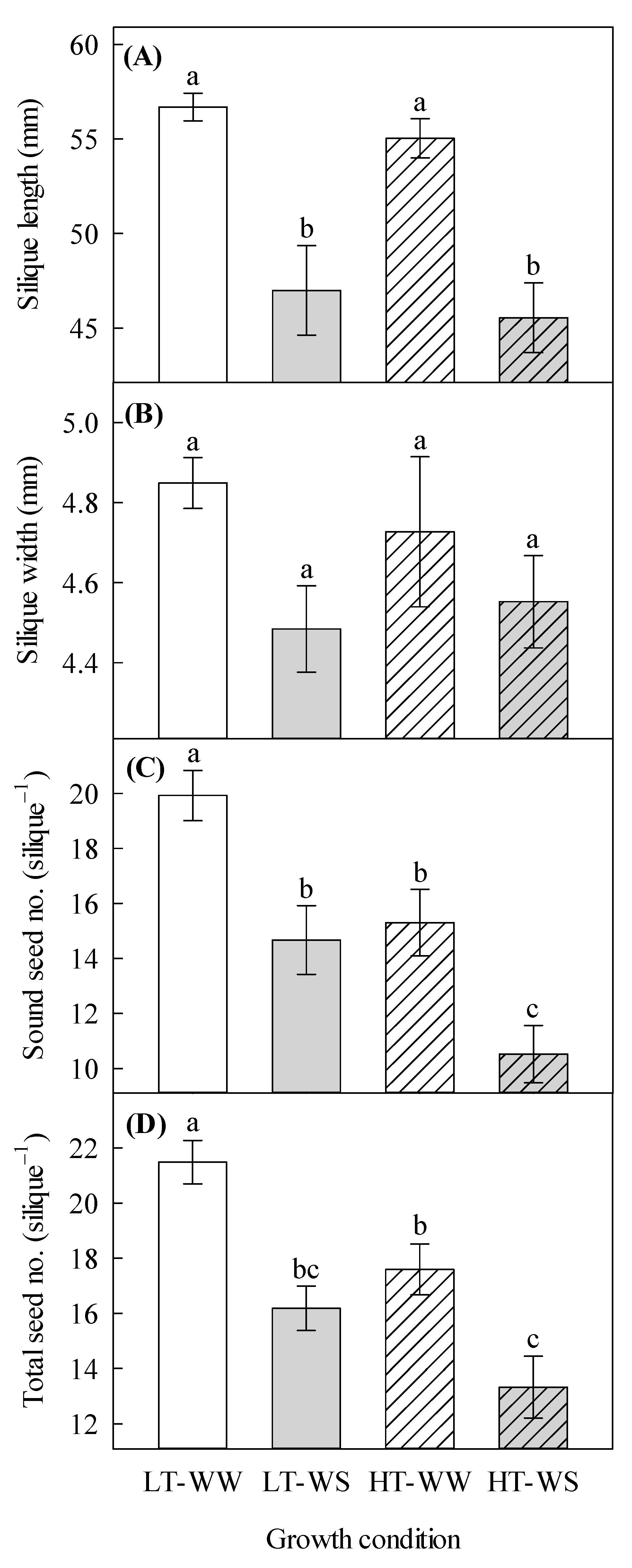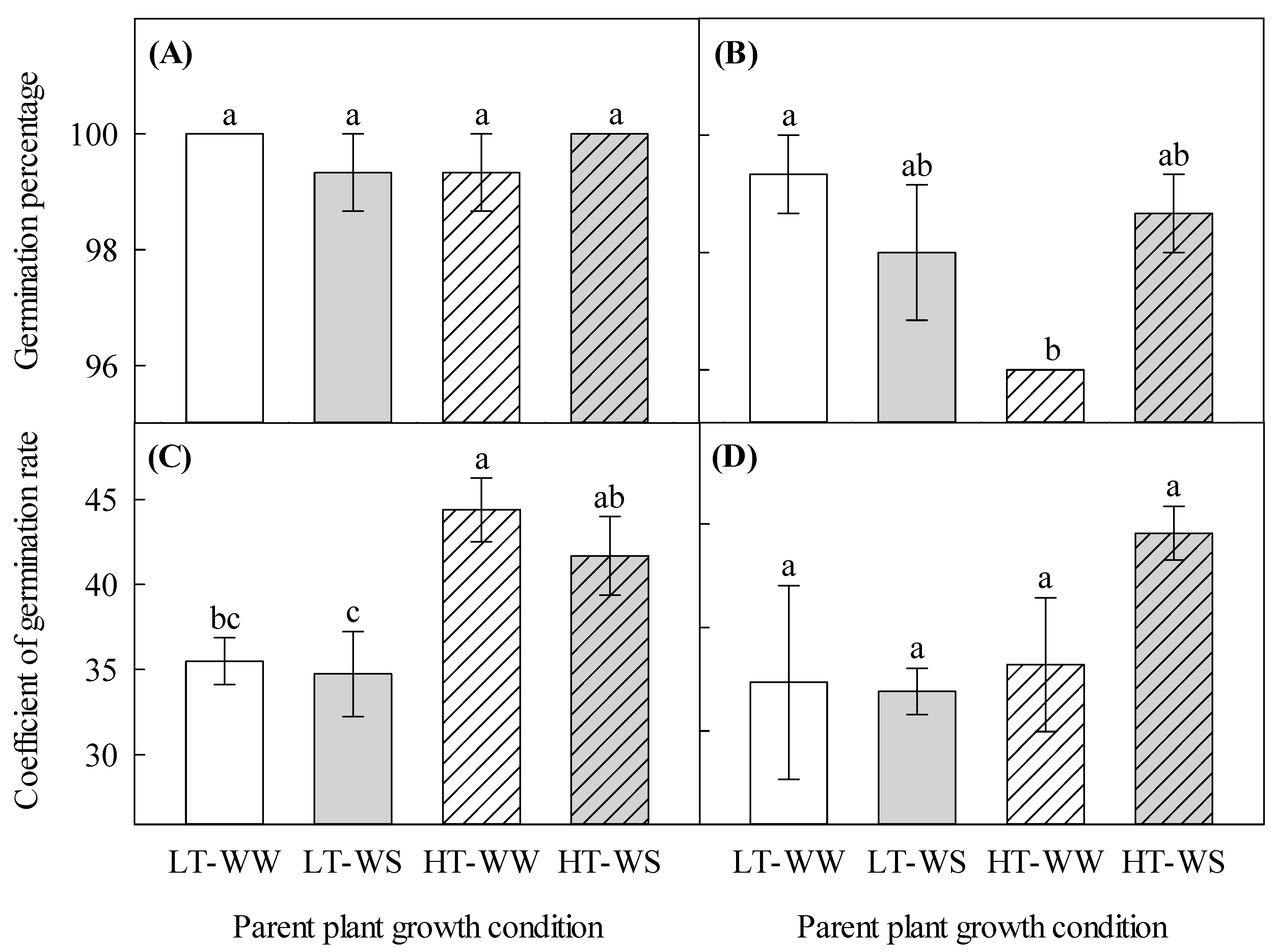Temperature and Watering Regime Interactions in Shaping Canola Reproductive Yield and Seed Quality
Abstract
:1. Introduction
2. Materials and Methods
2.1. Plant Materials and Growth Conditions
2.2. Measurement of Floral Traits
2.3. Measurement of Nectar
2.4. Measurement of Silique and Seed Traits
2.5. Seed Germination Tests
2.6. Data Analysis
3. Result
3.1. Floral Treats
3.2. Nectar Properties
3.3. Silique and Seed Traits
3.4. Seed Germination Pattern
4. Discussion
4.1. Effects of Temperature
4.2. Effects of Watering Regime
4.3. Interactive Effects of Temperature and Watering Regime
5. Conclusions
Author Contributions
Funding
Institutional Review Board Statement
Informed Consent Statement
Data Availability Statement
Acknowledgments
Conflicts of Interest
References
- Intergovernmental Panel on Climate Change (IPCC). Climate Change 2023: Synthesis Report; Contribution of Working Groups I, II, and III to the Sixth Assessment Report of the Intergovernmental Panel on Climate Change; IPCC: Geneva, Switzerland, 2023. [Google Scholar]
- Teixeira, E.I.; Fischer, G.; van Velthuizen, H.; Walter, C.; Ewert, F. Global hot-spots of heat stress on agricultural crops due to climate change. Agric. For. Meteorol. 2013, 170, 206–215. [Google Scholar] [CrossRef]
- Trenberth, K.E. Changes in precipitation with climate change. Clim. Res. 2011, 47, 123–138. [Google Scholar] [CrossRef]
- Arnell, N.W.; Lowe, J.A.; Challinor, A.J.; Osborn, T.J. Global and regional impacts of climate change at different levels of global temperature increase. Clim. Change 2019, 155, 377–391. [Google Scholar] [CrossRef]
- Berg, A.; Sheffield, J. Climate change and drought: The soil moisture perspective. Curr. Clim. Change Rep. 2018, 4, 180–191. [Google Scholar] [CrossRef]
- dos Santos, T.B.; Ribas, A.F.; de Souza, S.G.H.; Budzinski, I.G.F.; Domingues, D.S. Physiological responses to drought, salinity, and heat stress in plants: A review. Stresses 2022, 2, 113–135. [Google Scholar] [CrossRef]
- Tun, W.; Yoon, J.; Jeon, J.-S.; An, G. Influence of climate change on flowering time. J. Plant Biol. 2021, 64, 193–203. [Google Scholar] [CrossRef]
- Hatfield, J.L.; Prueger, J.H. Temperature extremes: Effect on plant growth and development. Weather Clim. Extrem. 2015, 10, 4–10. [Google Scholar] [CrossRef]
- Gérard, M.; Vanderplanck, M.; Wood, T.; Michez, D. Global warming and plant-pollinator mismatches. Emerg. Top. Life Sci. 2020, 4, 77–86. [Google Scholar]
- Hedhly, A. Sensitivity of flowering plant gametophytes to temperature fluctuations. Environ. Exp. Bot. 2011, 74, 9–16. [Google Scholar] [CrossRef]
- Descamps, C.; Boubnan, N.; Jacquemart, A.-L.; Quinet, M. Growing and flowering in a changing climate: Effects of higher temperatures and drought stress on the bee-pollinated species Impatiens glandulifera Royle. Plants 2021, 10, 988. [Google Scholar] [CrossRef]
- Khodorova, N.V.; Boitel-Conti, M. The role of temperature in the growth and flowering of geophytes. Plants 2013, 2, 699–711. [Google Scholar] [CrossRef] [PubMed]
- Nozaki, K.; Fukai, S. Effects of high temperature on floral development and flowering in spray chrysanthemum. J. Appl. Hortic. 2008, 10, 8–14. [Google Scholar] [CrossRef]
- Pokharel, M.; Stamm, M.; Hein, N.T.; Jagadish, K.S.V. Heat stress affects floral morphology, silique set and seed quality in chamber and field grown winter canola. J. Agro Crop Sci. 2021, 207, 465–480. [Google Scholar] [CrossRef]
- Tushabe, D.; Altmann, F.; Koehler, E.; Woods, S.; Rosbakh, S. Negative effects of high-temperature stress on gametophyte performance and their consequences for seed reproduction in wild plants. Environ. Exp. Bot. 2023, 216, 105532. [Google Scholar] [CrossRef]
- Descamps, C.; Marée, S.; Hugon, S.; Quinet, M.; Jacquemart, A.-L. Species-specific responses to combined water stress and increasing temperatures in two bee-pollinated congeners (Echium, Boraginaceae). Ecol. Evol. 2020, 10, 6549–6561. [Google Scholar] [CrossRef]
- Krug, A.S.; Drummond, E.B.M.; Van Tassel, D.L.; Warschefsky, E.J. The next era of crop domestication starts now. Proc. Natl. Acad. Sci. USA 2023, 120, e2205769120. [Google Scholar] [CrossRef]
- Hampton, J.G.; Boelt, B.; Rolston, M.P.; Chastain, T.G. Effects of elevated CO2 and temperature on seed quality. J. Agric. Sci. 2012, 151, 154–162. [Google Scholar] [CrossRef] [PubMed]
- Abo Gamar, M.I.; Dixon, S.L.; Qaderi, M.M. Single and interactive effects of temperature, carbon dioxide and watering regime on plant growth and reproductive yield of two genotypes of Arabidopsis thaliana. Acta Physiol. Plant. 2021, 43, 124. [Google Scholar] [CrossRef]
- Dietz, K.-J.; Zörb, C.; Geilfus, C.-M. Drought and crop yield. Plant Biol. 2021, 23, 881–893. [Google Scholar] [CrossRef]
- Zhang, J.; Zhang, S.; Cheng, M.; Jiang, H.; Zhang, X.; Peng, C.; Lu, X.; Zhang, M.; Jin, J. Effect of drought on agronomic traits of rice and wheat: A meta-analysis. Int. J. Environ. Res. Public Health 2018, 15, 839. [Google Scholar] [CrossRef]
- Cohen, I.; Zandalinas, S.; Huck, C.; Fritschi, F.B.; Mittler, R. Meta-analysis of drought and heat stress combination impact on crop yield and yield components. Physiol. Plant. 2020, 171, 66–76. [Google Scholar] [CrossRef]
- Ostmeyer, T.; Parker, N.; Jaenisch, B.; Alkotami, L.; Bustamante, C.; Jagadish, S.V.K. Impacts of heat, drought, and their interaction with nutrients on physiology, grain yield, and quality in field crops. Plant Physiol. Rep. 2020, 25, 549–568. [Google Scholar] [CrossRef]
- Gupta, A.; Rico-Medina, A.; Caño-Delgado, A.I. The physiology of plant responses to drought. Science 2020, 368, 266–269. [Google Scholar] [CrossRef] [PubMed]
- Farooq, M.A.; Ma, W.; Shen, S.; Gu, A. Underlying biochemical and molecular mechanisms for seed germination. Int. J. Mol. Sci. 2022, 23, 8502. [Google Scholar] [CrossRef]
- Klupczyńska, E.A.; Pawłowski, T.A. Regulation of seed dormancy and germination mechanisms in a changing environment. Int. J. Mol. Sci. 2021, 22, 1357. [Google Scholar] [CrossRef] [PubMed]
- Egli, D.B.; TeKrony, D.M.; Heitholt, J.J.; Rupe, J. Air temperature during seed filling and soybean seed germination and vigor. Crop Sci. 2005, 45, 1329–1335. [Google Scholar] [CrossRef]
- Reed, R.C.; Bradford, K.J.; Khanday, I. Seed germination and vigor: Ensuring crop sustainability in a changing climate. Heredity 2022, 128, 450–459. [Google Scholar] [CrossRef]
- Evans, C.C.; Qaderi, M.M. Supplemental nitrogen alleviates the negative effects of higher temperature on the vegetative growth of canola regardless of carbon dioxide concentration. Plant Stress 2024, 13, 100521. [Google Scholar] [CrossRef]
- Jones, H.G. Plants and Microclimate: A Quantitative Approach to Environmental Plant Physiology, 3rd ed.; Cambridge University Press: Cambridge, UK, 2014. [Google Scholar]
- Elferjani, R.; Soolanayakanahally, R. Canola responses to drought, heat, and combined stress: Shared and specific effects on carbon assimilation, seed yield, and oil composition. Front. Plant Sci. 2018, 9, 1224. [Google Scholar] [CrossRef]
- McDormand, E.D.; Qaderi, M.M. Individual and interactive effects of temperature and watering regime on canola growth and physiological characteristics. Plant Environ. Interact. 2025, 6, e70030. [Google Scholar] [CrossRef]
- Secchi, M.A.; Fernandez, J.A.; Stamm, M.J.; Durrett, T.; Vara Prasad, P.V.; Messina, C.D.; Ciampitti, I.A. Effects of heat and drought on canola (Brassica napus L.) yield, oil, and protein: A meta-analysis. Field Crops Res. 2023, 293, 108848. [Google Scholar] [CrossRef]
- Ge, L.L.; Tian, H.Q.; Russell, S.D. Calcium function and distribution during fertilization in angiosperms. Am. J. Bot. 2007, 94, 1046–1060. [Google Scholar] [CrossRef] [PubMed]
- Qaderi, M.M.; Kurepin, L.V.; Reid, D.M. Growth and physiological responses of canola (Brassica napus) to three components of global climate change: Temperature, carbon dioxide and drought. Physiol. Plant. 2006, 128, 710–721. [Google Scholar] [CrossRef]
- Canadian Food Inspection Agency (CFIA). The Biology of Brassica napus L. (Canola/Rapeseed); Plant and Biotechnology Risk Assessment Unit, Plant Health Science Division, Canadian Food Inspection Agency: Ottawa, ON, Canada, 2017; Available online: https://inspection.canada.ca/plant-varieties/plants-with-novel-traits/applicants/directive-94-08/biology-documents/brassica-napus-l-/eng/1330729090093/1330729278970#a11 (accessed on 1 April 2024).
- Davis, A.R.; Pylatuik, J.D.; Paradis, J.C.; Low, N.H. Nectar-carbohydrate production and composition vary in relation to nectary anatomy and location within individual flowers of several species of Brassicaceae. Planta 1998, 205, 305–318. [Google Scholar] [CrossRef]
- Morrant, D.S.; Schumann, R.; Petit, S. Field methods for sampling and storing nectar from flowers with low nectar volumes. Ann. Bot. 2009, 103, 533–542. [Google Scholar] [CrossRef] [PubMed]
- Qaderi, M.M.; Reid, D.M.; Yeung, E.C. Morphological and physiological responses of canola (Brassica napus) siliquas and seeds to UVB and CO2 under controlled environment conditions. Environ. Exp. Bot. 2007, 60, 428–437. [Google Scholar] [CrossRef]
- Qaderi, M.M.; Reid, D.M. Combined effects of temperature and carbon dioxide on plant growth and subsequent seed germinability of Silene noctiflora. Int. J. Plant Sci. 2008, 169, 1200–1209. [Google Scholar] [CrossRef]
- SAS Institute. SAS/STAT User’s Guide, Version 9.4; SAS Institute: Cary, NC, USA, 2016. [Google Scholar]
- Descamps, C.; Quinet, M.; Baijot, A.; Jacquemart, A.L. Temperature and water stress affect plant-pollinator interactions in Borago officinalis (Boraginaceae). Ecol. Evol. 2018, 8, 3443–3456. [Google Scholar] [CrossRef]
- Delgado, T.; Leal, L.C.; El Ottra, J.H.L.; Brito, V.L.G.; Nogueira, A. Flower size affects bee species visitation pattern on flowers with poricidal anthers across pollination studies. Flora 2023, 299, 152198. [Google Scholar] [CrossRef]
- Brunet, J.; Thairu, M.W.; Henss, J.M.; Link, R.I.; Kluever, J.A. The effects of flower, floral display, and reward sizes on bumblebee foraging behavior when pollen is the reward and plants are dichogamous. Int. J. Plant Sci. 2015, 176, 811–819. [Google Scholar] [CrossRef]
- Lev-Yadun, S.; Gould, K.S. Role of anthocyanins in plant defence. In Anthocyanins: Biosynthesis, Functions, and Applications; Gould, K., Davies, K., Winefield, C., Eds.; Springer: New York, NY, USA, 2009; pp. 21–48. [Google Scholar]
- Kaur, S.; Tiwari, V.; Kumari, A.; Chaudary, E.; Sharma, A.; Ali, U.; Garg, M. Protective and defensive role of anthocyanins under plant abiotic and biotic stresses: An emerging application in sustainable agriculture. J. Biotechnol. 2023, 361, 12–29. [Google Scholar] [CrossRef]
- Ichimura, K.; Niki, T.; Matoh, M.; Masayoshi, N. High temperature under low light conditions suppresses anthocyanin biosynthesis in snapdragon petals associated with decreased sugar levels. Sci. Hortic. 2021, 290, 110510. [Google Scholar] [CrossRef]
- Lohani, N.; Singh, M.B.; Bhalla, P.L. Short-term heat stress during flowering results in a decline in canola seed productivity. J. Agro Crop Sci. 2021, 208, 486–496. [Google Scholar] [CrossRef]
- Larios, E.; Venable, D.L. Selection for seed size: The unexpected effects of water availability and density. Funct. Ecol. 2018, 32, 2216–2224. [Google Scholar] [CrossRef]
- Liu, J.; Hasanuzzaman, M.; Wen, H.; Zhang, J.; Peng, T.; Sun, H.; Zhao, Q. High temperature and drought stress cause abscisic acid and reactive oxygen species accumulation and suppress seed germination growth in rice. Protoplasma 2019, 256, 1217–1227. [Google Scholar] [CrossRef]
- Khaeim, H.; Kende, Z.; Balla, I.; Gyuricza, C.; Eser, A.; Tarnawa, A. The effect of temperature and water stresses on seed germination and seedling growth of wheat (Triticum aestivum L.). Sustainability 2022, 14, 3887. [Google Scholar] [CrossRef]
- Sghaier, A.H.; Tarnawa, Á.; Kovács, G.P.; Gyuricza, C.; Kende, Z. The effects of temperature and water on the seed germination and seedling development of rapeseed (Brassica napus L.). Plants 2022, 11, 2819. [Google Scholar] [CrossRef] [PubMed]
- Flores, J.; Pérez-Sánchez, R.M.; Jurado, E. The combined effect of water stress and temperature on seed germination of Chihuahuan Desert species. J. Arid. Environ. 2017, 146, 95–98. [Google Scholar] [CrossRef]
- Baskin, C.C.; Baskin, J.M. Seeds: Ecology, Biogeography, and Evolution of Dormancy and Germination, 2nd ed.; Academic Press: San Diego, CA, USA, 2014. [Google Scholar]
- Rering, C.C.; Franco, J.G.; Yeater, K.M.; Mallinger, R.E. Drought stress alters floral volatiles and reduces floral rewards, pollinator activity, and seed set in a global plant. Ecosphere 2020, 11, e03254. [Google Scholar] [CrossRef]
- Nicolson, S.W. Sweet solutions: Nectar chemistry and quality. Phil. Trans. R. Soc. B 2022, 377, 20210163. [Google Scholar] [CrossRef]
- Qaderi, M.M.; Reid, D.M. Crop responses to elevated carbon dioxide and temperature. In Climate Change and Crops; Singh, S.N., Ed.; Springer: New York, NY, USA, 2009; pp. 1–18. [Google Scholar]
- Minami, A.; Kang, X.; Carter, C.J. A cell wall invertase controls nectar volume and sugar composition. Plant J. 2021, 107, 1016–1028. [Google Scholar] [CrossRef] [PubMed]
- Chen, L.; Liu, X.; Huang, X.; Luo, W.; Long, Y.; Greiner, S.; Rausch, T.; Zhao, H. Functional characterization of a drought-responsive invertase inhibitor from maize (Zea mays L.). Int. J. Mol. Sci. 2019, 20, 4081. [Google Scholar] [CrossRef] [PubMed]
- US Canola Association. Pollinator Health. Available online: https://www.uscanola.com/crop-production/pollinator-health/ (accessed on 8 April 2024).





| Source | df | Sepal Length | Sepal Width | Petal Length | Petal Width | |
|---|---|---|---|---|---|---|
| Temperature (T) | 1 | 2.71 | 0.14 | 1.48 | 31.73 ** | |
| Main plot error | 4 | – | – | – | – | |
| Watering regime (W) | 1 | 12.52 * | 1.56 | 0.02 | 0.99 | |
| T × W | 1 | 0.00 | 1.13 | 0.55 | 0.64 | |
| Subplot error | 4 | – | – | – | – | |
| Source | df | Short stamen length | Long stamen length | Carpel length | Flavonoids | Anthocyanins |
| Temperature (T) | 1 | 0.66 | 1.79 | 4.20 | 4.96 | 11.30 * |
| Main plot error | 4 | – | – | – | – | – |
| Watering regime (W) | 1 | 0.07 | 0.29 | 1.94 | 0.55 | 5.86 |
| T × W | 1 | 2.10 | 0.12 | 2.28 | 0.84 | 0.57 |
| Subplot error | 4 | – | – | – | – | – |
| Trait | Temperature | Watering Regime | ||
|---|---|---|---|---|
| Lower | Higher | Well-Watered | Water-Stressed | |
| Short stamen length (mm) | 8.65 ± 0.19 A | 8.87 ± 0.13 A | 8.73 ± 0.50 A | 8.78 ± 0.13 A |
| Long stamen length (mm) | 10.36 ± 0.20 A | 10.73 ± 0.12 A | 10.48 ± 0.55 A | 10.61 ± 0.13 A |
| Carpel length (mm) | 9.46 ± 0.30 A | 10.24 ± 0.37 A | 10.17 ± 1.02 A | 9.53 ± 0.28 A |
| Petal flavonoids (µg cm−2) | 1.72 ± 0.12 A | 1.73 ± 0.03 A | 1.79 ± 0.08 A | 1.76 ± 0.04 A |
| Petal anthocyanins (µg cm−2) | 1.12 ± 0.01 B | 1.15 ± 0.00 A | 1.13 ± 0.02 A | 1.15 ± 0.01 A |
| Source | df | Nectar Volume per Flower | Nectar Sugar Concentration |
|---|---|---|---|
| Temperature (T) | 1 | 0.48 | 2.82 |
| Main plot error | 4 | – | – |
| Watering regime (W) | 1 | 13.16 * | 145.47 *** |
| T × W | 1 | 10.59 * | 0.08 |
| Subplot error | 4 | – | – |
| Source | df | Silique Length | Silique Width | Sound Seed Number | Total Seed Number |
|---|---|---|---|---|---|
| Temperature (T) | 1 | 0.86 | 0.19 | 22.11 ** | 18.16 * |
| Main plot error | 4 | – | – | – | – |
| Watering regime (W) | 1 | 36.68 ** | 2.58 | 15.74 * | 21.36 ** |
| T × W | 1 | 0.00 | 0.32 | 0.04 | 0.25 |
| Subplot error | 4 | – | – | – | – |
| Source | df | Full silique mass | Empty silique mass | Sound seed mass | Total seed mass |
| Temperature (T) | 1 | 5.96 | 1.46 | 10.60 * | 11.91* |
| Main plot error | 4 | – | – | – | – |
| Watering regime (W) | 1 | 15.41 * | 9.52 * | 13.18 * | 14.79 * |
| T × W | 1 | 0.05 | 0.04 | 0.05 | 0.03 |
| Subplot error | 4 | – | – | – | – |
| Trait | Temperature | Watering Regime | ||
|---|---|---|---|---|
| Lower | Higher | Well-Watered | Water-Stressed | |
| Full silique mass (mg silique−1) | 157.90 ± 15.32 A | 136.50 ± 13.11 A | 173.96 ± 24.80 A | 119.59 ± 7.61 B |
| Empty silique mass (mg silique−1) | 82.39 ± 7.74 A | 77.06 ± 7.70 A | 93.72 ± 13.83 A | 65.73 ± 3.46 B |
| Sound seed mass (mg silique−1) | 73.37 ± 8.16 A | 56.36 ± 6.49 A | 78.54 ± 13.93 A | 51.19 ± 5.52 B |
| Total seed mass (mg silique−1) | 75.51 ± 7.66 A | 58.59 ± 6.28 A | 80.24 ± 13.45 A | 53.86 ± 5.21 B |
| Source | df | Lower Germination Temperature | Higher Germination Temperature | ||
|---|---|---|---|---|---|
| Germination % | Germination Rate | Germination % | Germination Rate | ||
| Temperature (T) | 1 | 0.00 | 43.66 ** | 1.93 | 2.54 |
| Main plot error | 4 | – | – | – | – |
| Watering regime (W) | 1 | 0.00 | 0.42 | 0.23 | 0.83 |
| T × W | 1 | 2.00 | 0.14 | 4.48 | 1.10 |
| Subplot error | 4 | – | – | – | – |
Disclaimer/Publisher’s Note: The statements, opinions and data contained in all publications are solely those of the individual author(s) and contributor(s) and not of MDPI and/or the editor(s). MDPI and/or the editor(s) disclaim responsibility for any injury to people or property resulting from any ideas, methods, instructions or products referred to in the content. |
© 2025 by the authors. Licensee MDPI, Basel, Switzerland. This article is an open access article distributed under the terms and conditions of the Creative Commons Attribution (CC BY) license (https://creativecommons.org/licenses/by/4.0/).
Share and Cite
Babb, A.D.; Qaderi, M.M. Temperature and Watering Regime Interactions in Shaping Canola Reproductive Yield and Seed Quality. Seeds 2025, 4, 21. https://doi.org/10.3390/seeds4020021
Babb AD, Qaderi MM. Temperature and Watering Regime Interactions in Shaping Canola Reproductive Yield and Seed Quality. Seeds. 2025; 4(2):21. https://doi.org/10.3390/seeds4020021
Chicago/Turabian StyleBabb, Alyssa D., and Mirwais M. Qaderi. 2025. "Temperature and Watering Regime Interactions in Shaping Canola Reproductive Yield and Seed Quality" Seeds 4, no. 2: 21. https://doi.org/10.3390/seeds4020021
APA StyleBabb, A. D., & Qaderi, M. M. (2025). Temperature and Watering Regime Interactions in Shaping Canola Reproductive Yield and Seed Quality. Seeds, 4(2), 21. https://doi.org/10.3390/seeds4020021







